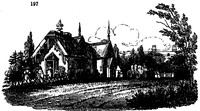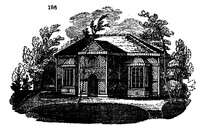594. Of gardens belonging to public companies there are a few in England, and these are chiefly the gardens of botanical and horticultural societies, which will be noticed under the head of 'Botanic Gardens,' of zoological societies, and of proprietors of medicinal springs, or baths, &c. The garden of the Zoological Society, in the Regent's Park, was commenced in 1826. It is of limited extent, but full of interest from the number of structures which it contains for animals; and as a garden, it displays some varied borders, well stocked with showy plants, and kept in excellent order. There are also several walks planted with Turkey oaks and other ornamental trees. The garden of the Surrey Zoological Society was commenced in 1830; it contains some handsome structures, and, in particular, a curvilinear menagerie (fig. 195.), which combines a series of tropical quadrupeds and birds with exotic plants. Of the gardens of watering-places, that of Cheltenham is the most celebrated in England, though not eminent for its garden scenery. At Wingfield Spa, in Windsor Forest, extensive walks are laid out in a natural coppice wood, and ornamented with seats, and rustic buildings. A rustic pump-room (fig. 196.) has also been erected, and a deserted nobleman's house in the neighbourhood has been turned into an hotel. At Norwood, in Surrey, the gardens at the Beulah Spa present a considerable variety of scenery, and exhibit a tolerable collection of plants; they are entered by a picturesque lodge (fig. 197.), and contain a number of curious and ornamental buildings. The taste for public gardens of this description if evidently on the increase in Britain; and we should not be surprised, if at no distant time they were to combine with them parks, and various other sources of recreation and enjoyment, now exclusively possessed, at least in Britain, by the wealthy.





